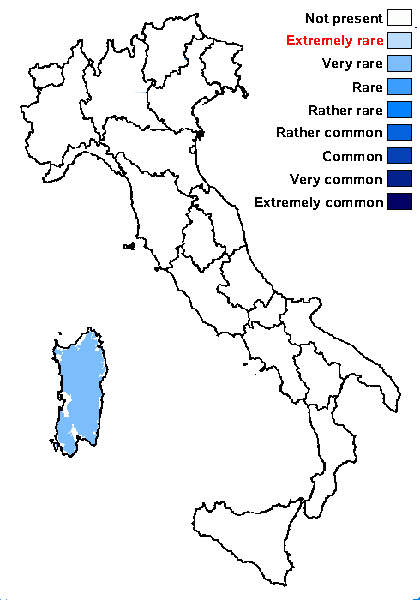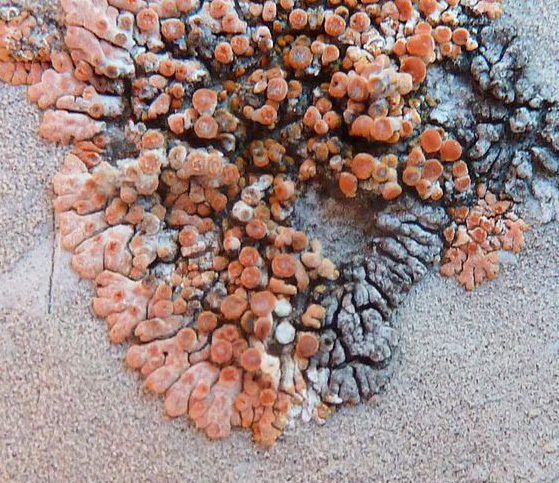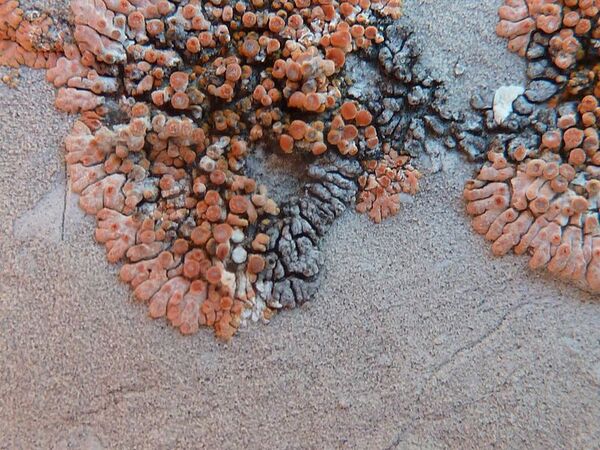Verrucula arnoldaria Nav.-Ros. & Cl. Roux
in Navarro-Rosinés & al., Bull. Soc. linn. Provence, 58: 152, 2007.
Synonyms:
Distribution: C - Sar.
Description: Thallus crustose, areolate or verrucose-areolate, growing on the thalli of Calogaya arnoldii. Areoles scattered to crowded, 0.1-0.8(-1) mm wide, 0.1-0.4 mm thick, strongly convex, grey-brown, but densely white-grey-pruinose, with brown to black margins and lower surface. Cortex 10-12 µm thick, of 1-3 layers of pale brown cells, covered with a 5-11 µm thick epinecral layer and a thick layer of large crystals; medulla white, 100-300 µm thick, dense, filled by crystals and substrate particles, I-. Perithecia black, 0.2-0.24 mm across, globose, immersed in the areoles or slightly projecting with the uppermost part. Involucrellum absent; exciple 25-35 µm thick at base, paraplectenchymatous, colourless except around the ostiole; hymenium colourless, I+ reddish; hamathecium of periphyses along the ostiolar channel, pseudoparaphyses in upper part of the perithecium, and paraphyses disappearing early; pseudoparaphyses 15-30 x 1.5-3 μm. Asci 8-spored, clavate, bitunicate, with a thin tholus reacting I-, Verrucaria-type. Ascospores 1-celled, hyaline, ellipsoid, (8.5-)10-13(-15) x (5.5-)6.5-7.5(-9.5) μm. Pycnidia black, globose immersed, Dermatocarpon-type, the wall colourless except at the brown apex. Conidia simple, bacilliform, 4.5-7.5 x (0.5-)1-1.5 μm. Photobiont chlorococcoid. Spot tests: K-, C-, KC-, P-, UV-. Chemistry: without lichen substances.
Note: a recently-described parasite of Calogaya arnoldii, certainly more widespread in Italy.
Growth form: Crustose
Substrata: rocks
Photobiont: green algae other than Trentepohlia
Reproductive strategy: mainly sexual
paras Calogaya arnoldii
Commonnes-rarity: (info)
Alpine belt: absent
Subalpine belt: extremely rare
Oromediterranean belt: very rare
Montane belt: very rare
Submediterranean belt: very rare
Padanian area: absent
Humid submediterranean belt: very rare
Humid mediterranean belt: absent
Dry mediterranean belt: absent

Predictive model
Growth form: Crustose
Substrata: rocks
Photobiont: green algae other than Trentepohlia
Reproductive strategy: mainly sexual
paras Calogaya arnoldii
Commonnes-rarity: (info)
Alpine belt: absent
Subalpine belt: extremely rare
Oromediterranean belt: very rare
Montane belt: very rare
Submediterranean belt: very rare
Padanian area: absent
Humid submediterranean belt: very rare
Humid mediterranean belt: absent
Dry mediterranean belt: absent

Predictive model
 INDEX FUNGORUM
INDEX FUNGORUM
 GBIF
GBIF



